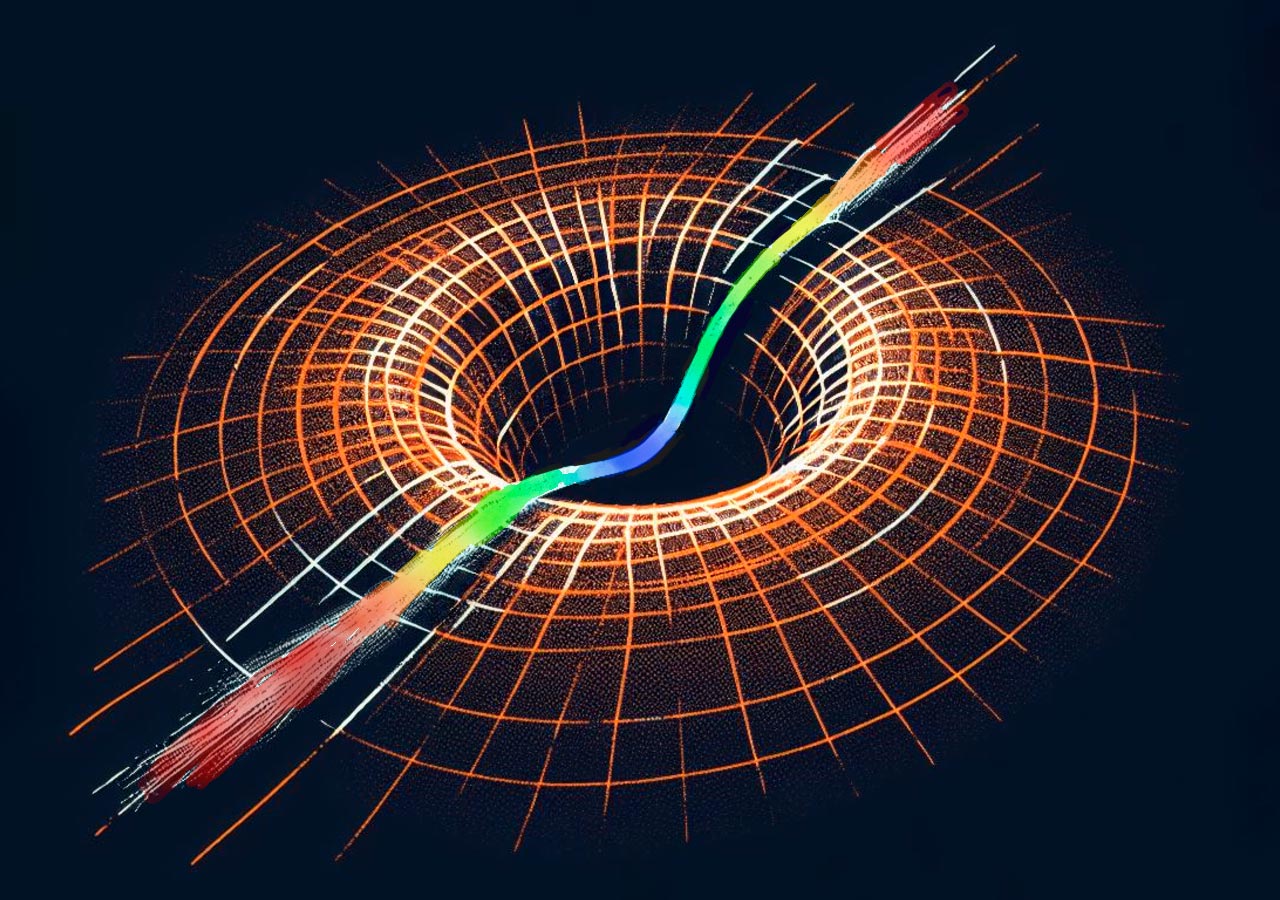
Artistic depiction of a wave encountering dramatically curved spacetime. Image source: Mattias Koivurova, University of Eastern Finland
Researchers have derived a new wave equation, linking wave mechanics to the theory of general relativity and the arrow of time, providing solutions to long-standing physics debates and offering applications for new materials.
Researchers at the University of Tampere and the University of Eastern Finland have reached a milestone in a study where they have deduced a new type of wave equation, which applies to accelerated waves. The new formalism turned out to be unexpectedly fertile ground for the study of wave mechanics, with direct links between accelerating waves, the general theory of relativity, as well as the arrow of time.
The interaction of light with matter
When light interacts with matter, the light appears to slow down. This is not a new observation and standard wave mechanics can describe most of these everyday phenomena.
For example, when light falls on an interface, the standard wave equation is satisfied on both sides. To solve such a problem analytically, one must first find what the wave looks like on both sides of the interface, and then use electromagnetic boundary conditions to connect the two sides together. This is called the partial continuous solution.
However, at the boundary, the incident light must accelerate. So far, this has not been calculated.
“Basically, I found a very elegant way to derive the standard wave equation in 1+1 dimensions. The only assumption I needed was that the speed of the wave is constant. Then I said to myself: What if it is not always constant? : “That turns out to be a really good question.”
By assuming that the speed of a wave can change over time, the researchers were able to write what they call the accelerating wave equation. While writing the equation was simple, solving it was another matter.
“The solution seemed to make no sense. Then it occurred to me that it was behaving in ways reminiscent of relativistic effects,” Koivorova recounts.
Working with the Theoretical Optics and Photonics Group, led by Associate Professor Marco Ornigotti from the University of Tampere, the researchers have finally made progress. To get solutions to behave as expected, they needed a constant reference speed – the speed of light in a vacuum. According to Koivorova, everything made sense after she realized this. What followed was an investigation into the surprisingly far-reaching consequences of formalism.
No hope for a time machine?
In a surprising result, the researchers showed that for accelerating waves, there is a well-defined direction to time; The so-called “arrow of time”. This is because the accelerating wave equation only allows solutions in which time flows forward, but never backwards.
“The direction of time usually comes from thermodynamics, where increasing entropy shows the direction in which time moves,” Koivorova says.
However, if the flow of time is reversed, the entropy will begin to decrease until the system reaches the lowest state of entropy. Then the entropy will be free to increase again.
This is the difference between “macroscopic” and “microscopic” arrows of time: while entropy unambiguously determines the direction of time for large systems, nothing determines the direction of time for individual particles.
“However, we would expect individual particles to behave as if they had a constant time direction!” says Koivurova.
Since the accelerated wave equation can be derived from geometric considerations, it is general, and represents all wave behavior in the world. This in turn means that the constant direction of time is also a general property of nature.
Relativity triumphs over controversy
Another property of the framework is that it can be used to analytically model continuous waves everywhere, even across interfaces. This in turn has some important implications for the conservation of energy and momentum.
“There is this very famous debate in physics, called the Abraham-Minkowski debate. The debate is that when light enters a medium, what happens to its momentum? Minkowski said that momentum increases, while Abraham insisted that it decreases,” Ornigotti explains.
Notably, there is empirical evidence to support both sides.
“What we showed is that from the point of view of the wave, nothing happens to its momentum. In other words, the momentum of the wave is conserved,” Koivorova continues.
What allows momentum to be maintained are relativistic effects. “We found that we can attribute a ‘good time’ to the wave, which is exactly analogous to the good time in general relativity,” says Ornigotti.
Since the wave experiences a different time than laboratory time, the researchers found that accelerating waves also experience time expansion and contraction in length. Koivorova points out that length contraction is precisely what makes it appear as if wave momentum is not conserved within a physical medium.
Exotic applications
The new approach is equivalent to the standard formulation for most problems, but it has an important extension: time-varying materials. Time-varying media light will experience sudden and uniform changes in material properties. The waves inside these materials are not solutions of the standard wave equation.
This is where the accelerated wave equation comes into the picture. It allows researchers to develop analytical models of situations that were previously only accessible digitally.
Such situations involve an exotic hypothetical substance called a turbulent photonic time crystal. Recent theoretical research has shown that a wave propagating within said material will slow down dramatically, while also increasing dramatically in energy.
“Our formalism shows that the observed change in pulse energy is due to the curved spacetime that the pulse passes through. In such cases, local energy conservation is violated,” says Ornigotti.
The research has wide-ranging implications, from everyday visual effects to laboratory tests of the general theory of relativity, giving insight into why time has a preferred direction.
Reference: “Time-Varying Media, Relativity, and the Arrow of Time” by Matias Koivurova, Charles W. Robson, and Marco Ornigotti, October 19, 2023, optica.
doi: 10.1364/optica.494630

“Web maven. Infuriatingly humble beer geek. Bacon fanatic. Typical creator. Music expert.”

:quality(85)/cloudfront-us-east-1.images.arcpublishing.com/infobae/LKGZZPZZ6THIZNWF5WHDNKDV64.jpg)


More Stories
NASA Commercial Crew Comparison Boeing Starliner and SpaceX Dragon
Japanese “Moon Sniper” brings back images after the third long lunar night
Weather web maps on the exoplanet WASP-43b